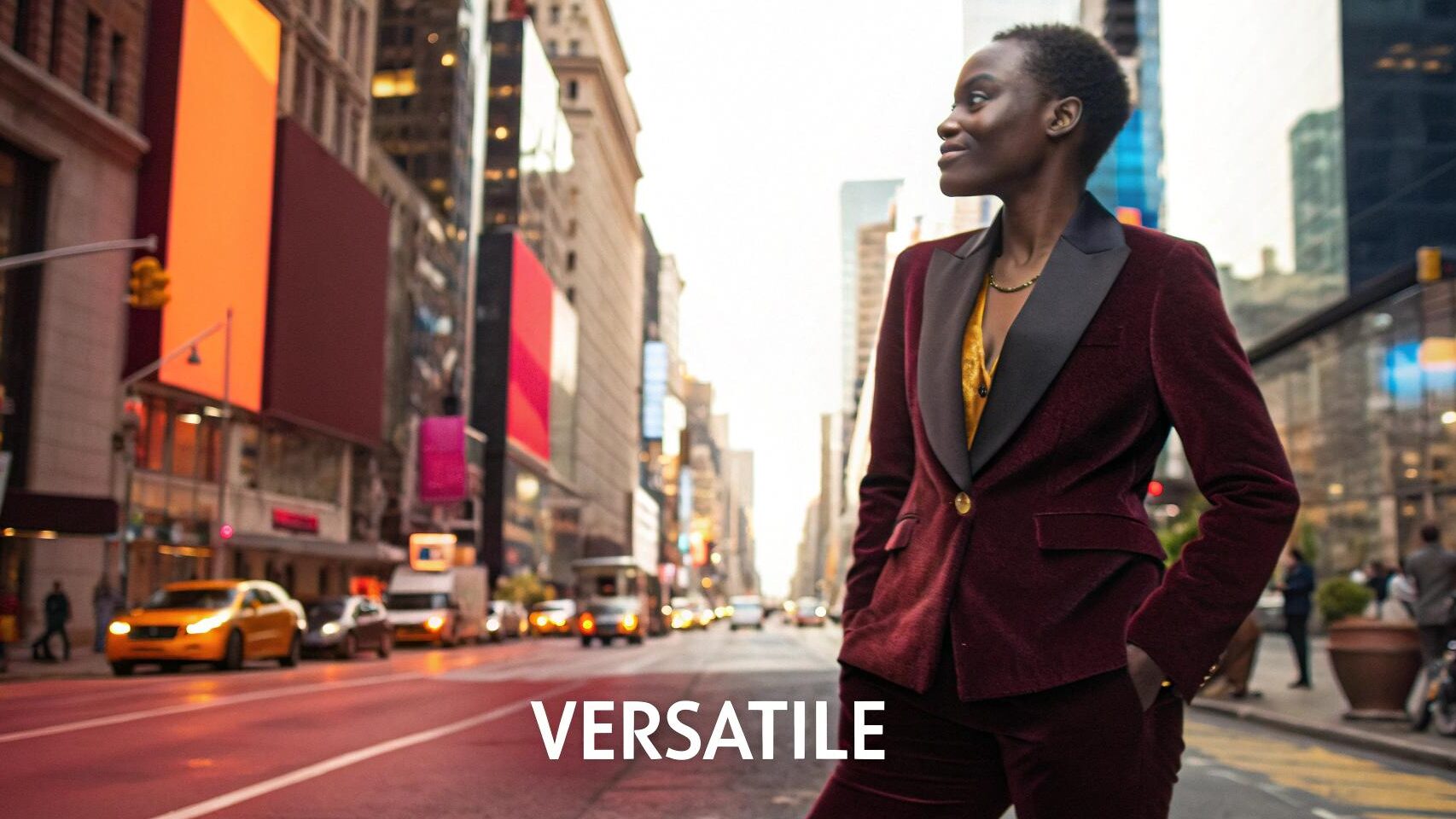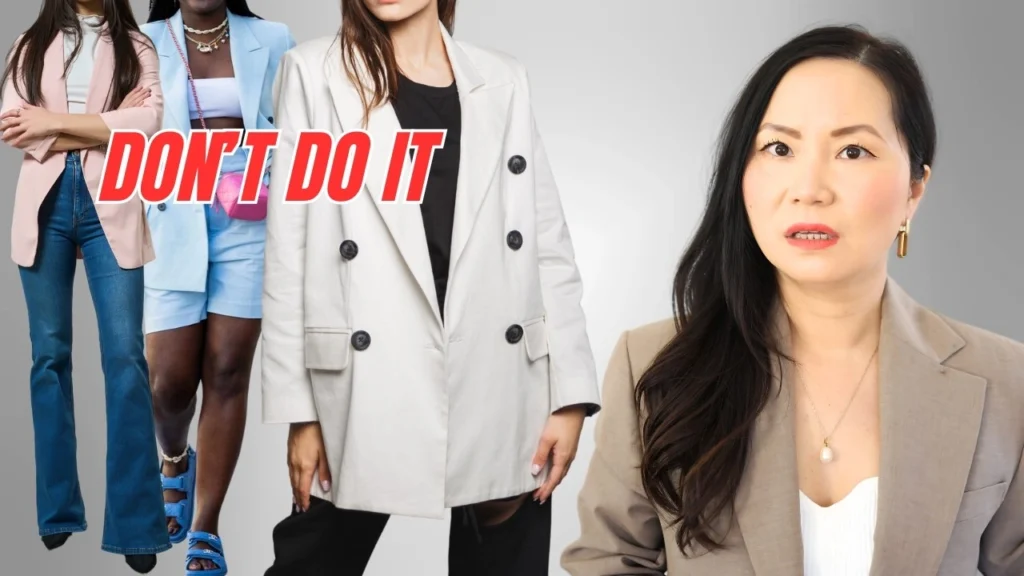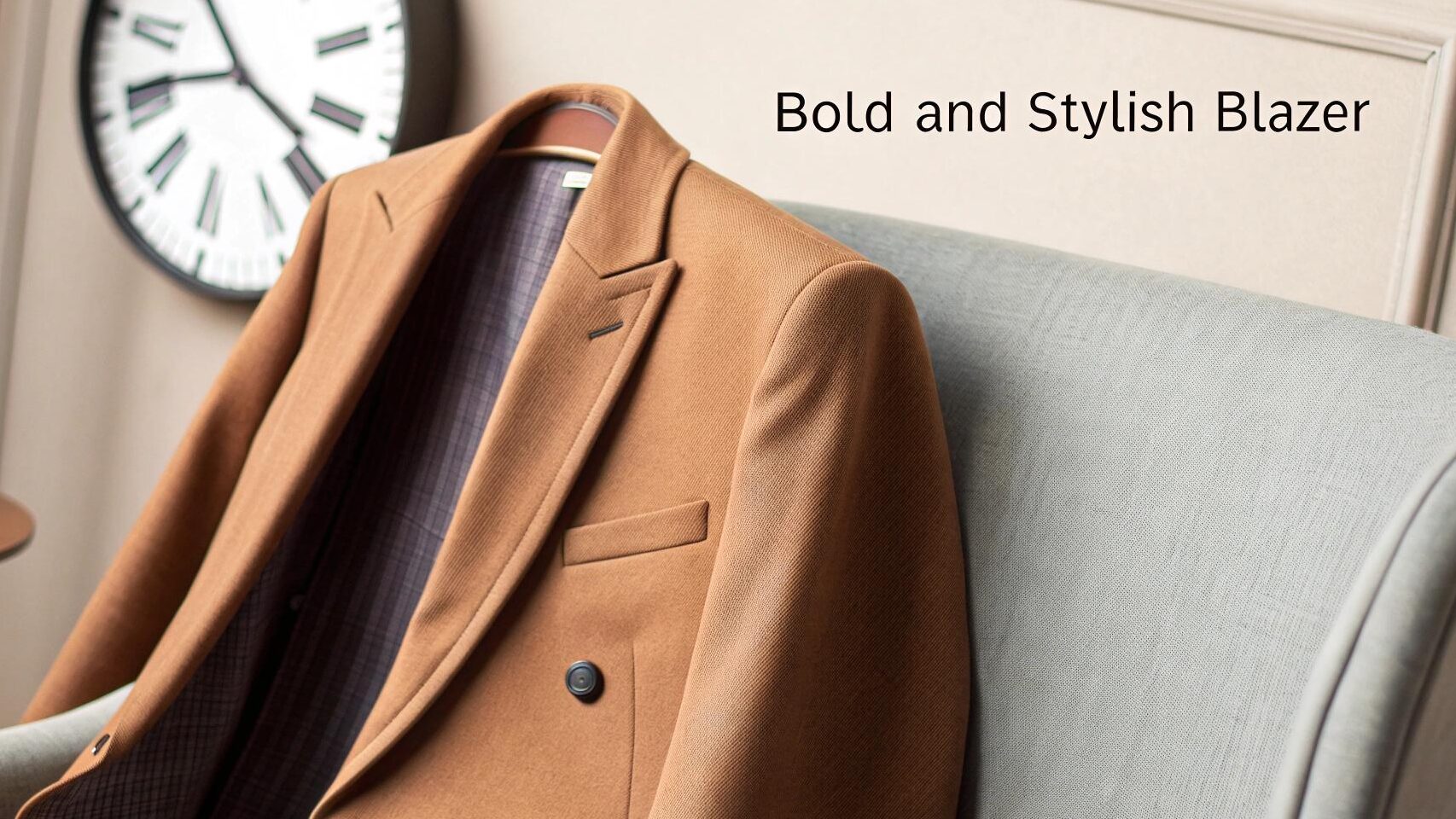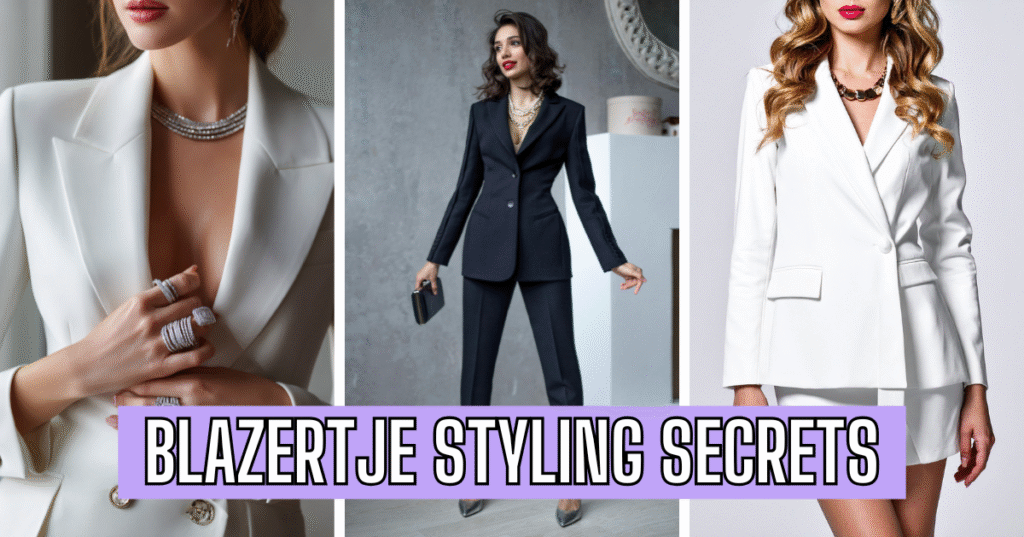What is a Blazertje?
A blazertje is a modern adaptation of the classic blazer, derived from Dutch where “-tje” is a diminutive suffix meaning “little blazer”. This garment is a stylish, relaxed take on the classic blazer. It strikes a balance between formal and casual looks. The blazertje is different from regular blazers. It usually has a shorter or cropped length, ending near the waist or hip.
The main features include a relaxed, boxy shape. It uses lighter fabrics like linen, cotton blends, soft knits, and unstructured wool. Blazers also have little shoulder padding. They often feature bold patterns or fun colors, setting them apart from more formal styles.
Blazers started in 19th-century Britain. They were worn by rowing clubs and elite schools to show unity. The word “blazer” comes from a warmup jacket worn by the Lady Margaret Boat Club in Cambridge, England. Its bright red color inspired the name.
The blazertje stands out because of its flexible design. It works well in many different settings. It easily shifts from smart-casual to formal. You can wear it with jeans for casual days or tailored trousers for work. This versatility makes the blazertje a must-have in any wardrobe. It blends elegance and comfort perfectly.
Why Blazertje Is Trending
The blazertje is popular because it perfectly combines formal style with casual comfort. This garment is now essential for professionals. The rise of hybrid work environments has made versatility in wardrobes important. The move to relaxed dress codes makes the blazertje a great choice for people working from home and in offices.
Fashion sustainability trends have furthermore contributed to the blazertje’s prominence. Its classic design is a year-round must-have. It goes beyond seasonal trends, making it a smart investment. The minimalist movement has grown in popularity. The blazertje shows the “less is more” idea with its simple lines and versatile style.
Social media has sped up the blazertje trend. Fashion influencers are showing off new styling ideas. Celebrity endorsements have boosted its status. Famous people often wear blazertjes with casual denim or evening outfits.
The current preference for gender-fluid fashion has also played a role in the blazertje’s ascendance. Its shape suits all body types and gender expressions. This mirrors the fashion industry’s move toward inclusivity and versatility. The blazertje shows a modern way to dress. It’s practical but refined, structured yet comfortable. This style fits well with today’s lifestyle needs.
How Blazertje Styling Has Evolved Over Time

The blazer’s journey began in the 19th century. It started with rowing teams and later became a fashion essential. The blazer was first made for certain occasions, but it has changed a lot over the years. Fashion trends have reshaped its style.
From formal blazers to casual streetwear
In the 1950s and 1960s, the blazer escaped elite circles. UK youth subcultures took school blazers and turned them into symbols of rebellion. By the 1980s, the blazer was seen as part of the ‘power suit.’ Over 50% of women had joined the workforce. Subsequently, formal blazers transcended office boundaries, becoming interchangeable with casual wear. This transition started formal streetwear. It mixes traditional tailored styles with relaxed, urban looks. This mix made it easy to adapt to different social settings since traditional dress codes became less distinct.
Rise of gender-neutral and oversized fits
The blazertje is now a key piece in gender-neutral fashion. It features designs that fit various body types well. Notably, the oversized blazer gained popularity through vintage shopping and alternative tailoring. This silhouette provides a softer structure, making it suitable beyond office environments. Currently, oversized blazertjes represent a genderless, seasonless garment holding significance across customer demographics. This inclusive approach breaks style boundaries. It invites all genders to embrace this versatile piece. Modern blazers mix classic styles with new features. They come in various fabrics and styles. This lets everyone show their identity, regardless of gender.
Blazertje Outfit Ideas from Morning to Night
The blazertje offers versatile styling options. You can wear it at different times of day. It pairs well with various outfits for any setting.
Morning: Neutral blazertje + jeans + loafers
Neutral blazertje with jeans make a great semi-casual outfit. It’s perfect for daytime events or relaxed workplaces. This combination offers a relaxed yet refined esthetic ideal for morning engagements. A fitted blazer with blue jeans creates a stylish look for women wanting to be polished. Loafers effectively complement this pairing, adding sophistication while maintaining comfort. Blazers in classic colors, like navy and charcoal, pair well with skinny and wide-leg jeans.
Afternoon: Cropped blazertje + midi skirt + flats
Cropped blazertjes perfectly balance proportions when paired with midi skirts for afternoon occasions. This pairing works excellently for office environments or casual business meetings. Choosing a blazer that hugs the waist highlights your shape without adding bulk. Ballet flats and loafers offer comfort for afternoon activities. They also keep your look professional. Textural contrast between pieces adds visual interest to this versatile combination.
Evening: Bold blazertje + slip dress + heels
Bold blazertjes layered over slip dresses create sophisticated evening ensembles. This mix, shown by style icons like Rihanna, balances nighttime glamor with a modern twist. Structured blazers and fluid slip dresses create a striking look. They also provide warmth and comfort. With heels, this outfit easily works for evenings, from dinner dates to formal events.
You Might Also Like: SkinPres T Results: Before & After
Common Blazertje Styling Mistakes to Avoid

Fit remains the most crucial factor when styling a blazertje effectively. Common styling errors can diminish even the most expensive garment’s appeal.
Wearing the wrong fit for your body type
Body-specific blazertje selection greatly impacts overall appearance. Hourglass figures look great in fitted styles that highlight the waist. Athletic builds, on the other hand, need structured shoulders for extra dimension. Petite individuals should opt for shorter blazers that hit above the hip. This helps keep their frame from looking overwhelmed. For broader shoulders, selecting blazertjes without excessive padding prevents an unbalanced silhouette. The shoulder seams must match your natural shoulder line. Sleeves should ideally stop at your wrist bone.
Over-accessorizing with bold prints
Excessive accessorizing compromises the blazertje’s inherent elegance. When you wear patterned blazertje (like checks, stripes, or bold prints), keep extra statement pieces to a minimum. This helps maintain visual harmony. A good rule is to pick one or two key accessories. Avoid using too many items that draw attention. This approach prevents competing focal points that can create a chaotic appearance.
Ignoring fabric choice for the season
Seasonal fabric selection affects both comfort and appearance. Wool keeps you warm and gives structure in winter. In summer, linen and cotton provide the breathability you need. Fabric weight affects how the blazer drapes on you. Heavier materials hold their shape well, but they can feel restrictive when it’s warm.
Forgetting to balance proportions
Proportion balance creates visual harmony. Pairing oversized blazertjes with slim-fitting bottoms creates intentional contrast, whereas matching loose pieces often appears unstructured. This principle particularly applies to cropped styles, which work best with high-waisted bottoms.
Why Blazertje is a Must-Have in Your Wardrobe
Investment pieces form the foundation of a well-curated wardrobe, with the blazertje standing out as perhaps the most practical garment. This versatile item has many uses. It works well as outerwear in mild weather, but it may not function well as a structured layer indoors. The blazertje is a styling chameleon. It can dress up casual outfits or tone down formal looks, depending on the situation.
From a practical perspective, blazertjes deliver exceptional cost-per-wear value through their year-round utility. Their lasting appeal allows for rotation in your wardrobe. This means you won’t have to store seasonal clothes for long periods. At first, the blazertje seems like a big investment. But it pays off with its long life and versatility.
Beyond practicality, blazertjes possess remarkable space efficiency. One carefully selected item can replace several specific pieces. This makes it key for minimalist wardrobes or travel bags. This spatial economy also includes maintenance. Quality blazertjes need less care than other statement pieces.
The blazertje’s greatest attribute remains its remarkable adaptability. It pairs well with workwear, casual outfits, or evening looks. It stands out without taking over the whole outfit. This multifunctional feature changes it from just a garment to a wardrobe essential. Few items can truly make this claim.
Blazertje vs. Traditional Blazer
Distinctions between the blazertje and traditional blazer manifest across multiple dimensions despite their shared lineage. Traditional blazers have structured shapes and strong shoulder padding. Blazertjes, on the other hand, are more relaxed. They use less padding, which allows for better movement. Traditional variants usually go below the hip. In contrast, blazertjes often stop at the waist or mid-hip. This creates noticeably different proportions.
Traditional blazers are linked to business settings. They feature tailored precision, heavier fabrics, and detailed finishing. Conversely, blazertjes occupy the middle ground between casual and formal attire through lighter materials and simplified construction. This key difference impacts when to wear each type. Traditional blazers can look too fancy for casual places. In contrast, blazertjes fit in well everywhere.
Traditional blazers have classic features. They include bold lapels, structured shoulders, and formal button setups. Blazertjes feature modern designs. They have narrower lapels, relaxed shoulders, and sometimes unique closures or details. Fabric choice sets these garments apart. Traditional blazers use wool blends, tweed, or heavy cotton. Blazertjes usually use lighter materials, such as linen, soft cotton, or performance fabrics. This choice adds comfort.
Nonetheless, both garments share core characteristics including front closures, lapels, and pocket detailing. The difference shows how workplace norms and lifestyles are changing. People want versatile clothes that go beyond strict dress codes but still look good.
The Blazertje has taken the world by storm. From Milan’s runways to Seoul’s streets, it’s now a fashion must-have. Its style mirrors the classic blazers from brands like Zara, H&M, Mango, and Massimo Dutti. These brands have changed smart-casual. They mix tailored looks with streetwear comfort. The Blazertje is now a must-have for any season. Styled with denim for a casual vibe or layered over a dress for a night out, it shows the versatility that fashion houses love. Even luxury brands like Balmain and Saint Laurent now embrace blazer-inspired cuts. This shows that structured style never goes out of trend. The Blazertje stands at the intersection of comfort, confidence, and cosmopolitan flair
The Future of Blazertje in Fashion

Fashion forecasting indicates that blazertjes will continue to evolve alongside changing workplace dynamics and consumer preferences. As remote and hybrid work become the norm, blazertjes will likely add more comfort features. They will do this while keeping their stylish look. This change will likely show up in technical fabrics. These fabrics will offer more stretch, better breathability, and less wrinkling.
Sustainability considerations will undoubtedly shape the blazertje’s future trajectory. Manufacturers are increasingly exploring eco-friendly materials including recycled polyester, organic cotton, and innovative plant-based textiles. This environmental awareness goes beyond materials. It focuses on production methods too. There’s a strong emphasis on clear supply chains and lowering carbon footprints.
Technological integration represents another frontier for blazertje development. Smart fabrics that control temperature or hide devices fit today’s consumers’ needs.
The line between formal and casual is fading. This will push designers to rethink the blazertje and add adaptive features. Removable parts, reversible designs, and modular pieces let one garment have many uses.
Blazertjes will likely see color palettes grow beyond traditional neutrals. Expect bolder hues and patterns that show off personal style. The core silhouette will keep its familiar shape. This way, the blazertje stays recognizable while adapting to modern fashion trends.
Conclusion
The blazertje is a great fix for many wardrobe issues. It tackles more outfit problems than almost any other layering piece. Its lasting charm comes from its great versatility. It works well in professional settings, casual gatherings, and evening events. This adaptability makes it a must-have item. It blends style and function for every season.
Beyond mere fashion considerations, the blazertje represents practical economy in wardrobe planning. A good piece meets many styling needs at once. It works as outerwear in mild weather and as a structured layer indoors. This dual-purpose nature contributes to superior cost-per-wear value when compared with single-function garments.
Quality blazertjes require minimal maintenance yet deliver substantial returns in terms of style enhancement. They can enhance casual looks or soften formal outfits. This makes them valuable in many fashion situations. The garment adapts to changing trends. It reflects how fashion evolves while keeping its core design intact.
Materials are evolving for sustainability. Eco-friendly fabrics are now key in blazertje design. This awareness of the environment adds to the garment’s built-in sustainability. Its long life and versatility make the blazertje a practical must-have and a smart choice for your wardrobe.
Read More: Yellow Facial Benefits: My Surprising 30-Day Skin Transformation
FAQs
Q1. How can I style a blazertje for different occasions throughout the day?
For mornings, pair a neutral blazertje with jeans and loafers for a semi-casual look. In the afternoon, try a cropped blazertje with a midi skirt and flats for a professional appearance. For evenings, layer a bold blazertje over a slip dress and add heels for a sophisticated ensemble.
Q2. What are the key differences between a blazertje and a traditional blazer?
A blazertje usually has a relaxed fit, light fabrics, and a shorter length than traditional blazers. Blazertjes offer versatility and comfort. They work well for casual and semi-formal occasions. In contrast, traditional blazers are more structured and formal.
Q3. Why has the blazertje become so popular in recent fashion trends?
The blazertje is popular because it strikes a great balance. It combines formal style with casual comfort. It fits well with today’s hybrid work setups, sustainability trends, and relaxed dress codes. Its versatility and adaptability to various styles and occasions have made it a wardrobe staple.
Q4. What are some common styling mistakes to avoid when wearing a blazertje?
Common mistakes include wearing the wrong fit for your body type, over-accessorizing with bold prints, ignoring fabric choice for the season, and forgetting to balance proportions. It’s important to choose a blazertje that complements your figure and to consider the overall outfit when styling.
Q5. How is the blazertje expected to evolve in future fashion trends?
Future blazertjes are likely to incorporate more comfort-oriented features, sustainable materials, and even technological integrations. We may see adaptations like removable elements, smart fabrics, and bolder color palettes. The main shape will stay familiar but will adapt to modern styles and practical needs.


